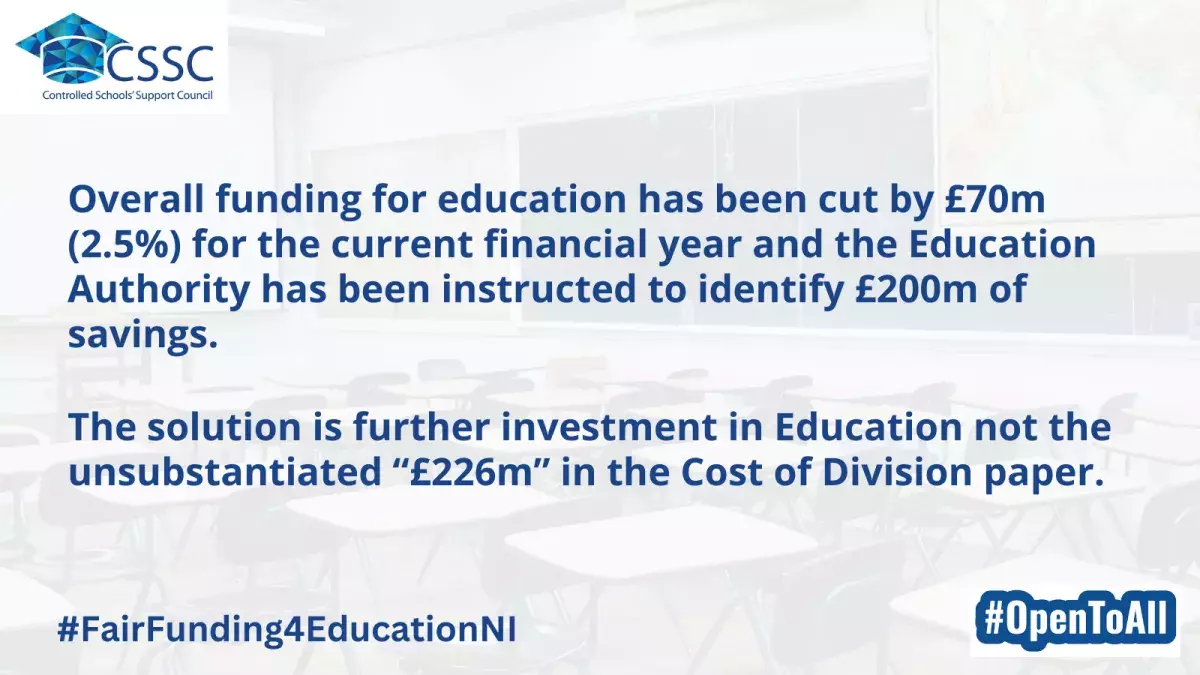- About us
- Schools
- Area planning
- Find your Schools’ Support Officer
- Best practice case studies
- Funding opportunities
- School vacancies
- Shared education
- #OpenToAll
- CSSC Award in Excellence in Educational Research
- Erasmus+
- CSSC Membership Survey 2022 – Results
- CSSC Sign Language programme - engaging with sign, a language for you and me
- Governors
- News
- Events
- Publications
- Ethos
- #OpenToAll
- Contact
- Search
CSSC response to The Cost of Division in NI paper
Overall funding for education has already been cut by £70m (2.5%) for the current financial year and the Education Authority has been instructed to identify a further £200m of savings. The solution is future investment in education not the unsubstantiated “£226m” in the Cost of Division paper.
The Department of Education (DE) agrees with CSSC’s analysis of the Transforming Education Paper ‘which it considers to be a flawed and oversimplified analysis’ vastly overinflating the cost of shared education (on average costing DE £4m per annum, not the £95.6m quoted). Read Department of Education NI statement here on the Cost of Division in Northern Ireland paper.

The Controlled Schools’ Support Council (CSSC) supports 547 controlled schools in Northern Ireland which include nursery, primary, secondary, grammar, integrated, special and Irish-medium schools. CSSC has outlined its significant concerns about the calculations, assumptions and methods used in the recently published ‘The Cost of Division in Northern Ireland’ paper. The paper was published as part of the Transforming Education (TE) programme, funded by the Integrated Education Fund.
Mark Baker Chief Executive, CSSC Chief Executive explained:
“At a time when our children and young people are being disadvantaged due to drastic education underfunding in comparison to other parts of the United Kingdom, it is imperative that any analysis of costs and potential savings is evidence based and accurate."
"Too often large memorable numbers are placed in the public domain without time being taken to fully read and challenge the arguments and listen to contrary opinion and evidence."
"Our concern is that the TE Cost of Division paper is being quoted by senior decision makers as definitive and being used to undermine the argument for fair funding for schools in Northern Ireland. The TE paper implies that £226m per year can be saved by eliminating perceived waste due to costs of division. The TE paper, unfortunately, provides headline figures which are becoming part of the public narrative without peer-review or collaborative discussion to substantiate that which is claimed and extending open and constructive dialogue.”
CSSC sets out in its response a commentary on significant elements of the paper, and the analysis on which they are based. Unfortunately, CSSC’s conclusions are that these findings are flawed, undermining their reliability, validity, and credibility.
Some of the cost areas CSSC would like further discussion around include:
- Surplus places in primary schools
- The TE paper refers to £67.2m related to a ‘cost’ of surplus places in primary schools. Surplus is identified as being the difference between approved and actual enrolment. Schools are not funded for the number of potential places they have available, they are funded for the number of pupils actually enrolled at the date of the annual DE school census.
- The TE paper refers to £67.2m related to a ‘cost’ of surplus places in primary schools. Surplus is identified as being the difference between approved and actual enrolment. Schools are not funded for the number of potential places they have available, they are funded for the number of pupils actually enrolled at the date of the annual DE school census.
- Potential savings from amalgamating 32 pairs of small rural primary schools
- The TE paper suggests there are ‘considerable’ savings to be made. CSSC initial calculations suggest it would only be marginal and calls for further debate.
- The TE paper suggests there are ‘considerable’ savings to be made. CSSC initial calculations suggest it would only be marginal and calls for further debate.
- Review of administration of schools in a complex system
- The TE paper refers to an additional cost of £9.8m from ‘duplication of services’. However, the bodies identified provide services to different groups of schools, rather than duplicating the services to the same schools.
- The TE paper refers to an additional cost of £9.8m from ‘duplication of services’. However, the bodies identified provide services to different groups of schools, rather than duplicating the services to the same schools.
- Spending in Shared Education
- Shared Education is the most significant element considered in the TE paper, with an annual cost estimate of over £100m. The most significant elements of the Shared Education funding come from external sources, which would not otherwise be available to NI.
- Shared Education Campus costs would still have been incurred if both schools involved, or groups of schools had received the necessary separate capital funding for their own facilities. By combining these costs into a shared facility, additional improved benefits are provided to all pupils.
- Flaws in the calculations on which the paper is based
- While the TE paper caveats that accuracy in calculations is difficult, unfortunately it goes on to provide a final definitive figure, based on an estimate which has then been elevated further for inflationary pressures.